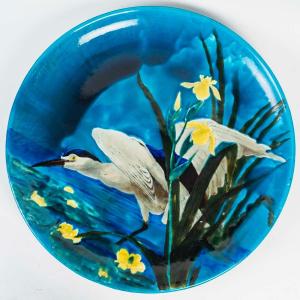Cricket among country flowers Pâte de verre vide-poche with decoration in high relief off a naturalistically modelled cricket.
The orthopteris treated in bright green, dark green and khaki, the flowers in ochre and the cordiform cup in yellow, shaded with green and blue.
Signed in the mould A. Walter Nancy, H. Bergé Sc.
Circa 1920
L.12cm - L.11cm
Pâte de verre material is produced by grinding glass into a fine powder, adding a binder to create a paste, and adding a fluxing medium to facilitate melting. The paste is brushed or tamped into a mold, dried, and fused by firing, meaning this is not only one of the most technically difficult manners in which to create glass objects.
Talented but too modest artist, Amalric WALTER died in indifference and was totally forgotten by the biographers who were mainly interested in the «Grands» of the School of Nancy. He received initial training as a ceramist at the Sèvres factory before setting up his own business.
It exhibits decorated earthenware and objects made of glass paste. In 1903, he opened the famous Daum crystal factory in Nancy and passed on his know-how of glass paste. After the 1914-1918 war, he set up his own business. An official text from 1926 in Nancy declared him to be the creator of the glass paste process. He received the diploma of honour at the Universal Exhibition in 1900, and the gold medal at the Nancy Exhibitions in 1909 and Brussels in 1910.
Henri Bergé, glass maker at Daum provides him with a large number of models that start his own production. His career culminated in the 1920s, marked by a craze for glass paste objects. This artist’s rating has been on the rise for a few years.
The Jacquot (1875-2015) jewellery shop on the rue des Dominicains in Nancy opened the workshops and furnaces of Amalric Walter in 1932 with a significant liability.











































 Le Magazine de PROANTIC
Le Magazine de PROANTIC TRÉSORS Magazine
TRÉSORS Magazine Rivista Artiquariato
Rivista Artiquariato